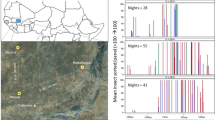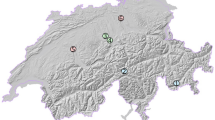Abstract
Porina moths (WISEANA spp.) in New Zealand (studied for the past 7 years at 9 trapping stations) show flight activity, 15 to 30 hr before the approach of low pressure cold fronts with rain or mist. The mechanism triggering this off, remains obscure. Consequently an hypothesis to explain this has been tested, namely, that variations in the ratios of positive to negative atmospheric small ions, might be the dynamic stimulus in the environment triggering off moth-emergence in spring and early summer. Continuous measurements were made of the small ion concentrations during the passage of weather fronts over Wellington. Simultaneously the daily insect biomass taken from an adjacent light trap was recorded and collated with moth flight records at other New Zealand trapping stations. A possible correlation between flight activity of the moths, and the passage of cold fronts and associated variations in atmospheric small ion ratios has been noticed.
Zusammenfassung
Porinamotten (WISEANA spp.), die in den letzten 7 Jahren an 9 Fangstationen in Neuseeland studiert wurden, zeigen eine Flugaktivität 15–30 Stunden vor Eintreffen einer Kaltfront mit Regen und Nebel. Die Ursachen dafür sind unbekannt. Die Hypothese wurde geprüft, ob Änderungen im Verhältnis der atmosphärischen positiven und negativen Kleinionen den Reiz darstellen. Die kleinen Ionen wurden während des Durchzugs von Wetterfronten über Wellington fortlaufend gemessen. Gleichzeitig wurde die tägliche Insektenmenge in einer Lichtfalle registriert und mit den Mottenflugangaben anderer Fangstationen verglichen. Es wurde eine mögliche Beziehung zwischen der Flugaktivität der Motten und dem Durchzug der Kaltfronten und zugehörigen Schwankungen des atmosphärischen Kleinionen-Verhältnisses festgestellt.
Resume
Les phalènes (espèces WISEANA) étudiées durant les 7 dernières années à 5 stations de piégeage en Nouvelles Zélande montrent une activité de vol marquée 15 à 30 heurs avant l'arrivée d'un front froid accompagné de pluie et de brouillard. Les raison de cette activité ne sont pas encore connues. On a étudié l'hypothèse selon laquelle le stimulus en est donné par une variation de la proportion des petits ions positifs et négatifs de l'atmosphère. On a ainsi mesuré de façon continue les petits ions durant le passage de fronts à Wellington. On a enregistré simultanément le nombre d'insectes pris chaque jour dans un piège lumineux et comparé ces chiffres à ceux provenant d'autres stations. On a alors pu constater une relation possible entre l'activité en vol des phalènes et le passage des fronts froids ainsi que des variations correspondantes du rapport des petits ions de l'atmosphère.
Similar content being viewed by others
References
CASWELL, A.E. (1967): The significance of electrified air. J.roy.Naval Sci. Service, 22: 111–117.
CHALMERS, J.A. (1949): Atmospheric Electricity. Oxford Clarendon Press, Oxford.
EDWARDS, D.K. (1960): Effects of experimentally altered unipolar air in density upon the amount of activity of the blow fly, CALLIPHORA VICINIA. Canad.J.Zool., 38: 899 and 1709-1091.
EDWARDS, D.K. (1961): Influence of electrical field on pupation and oviposition in NEPYTIA PHANTASMARIA (Lepid: Geometridae). Nature (Lond.), 191: 976–993.
FABRE, J.H. (1918): The Sacred Beetles and Others. Dodd Mead Co., New York.
HAINE, E. (1961): Do atmospheric electrical factors have an influence on the activity changes of small insects, in particular on the moulting and reproduction rates of aphids? Forsch. ber. Landes Nordrh-Westfalen, 974, 1–80.
HAINE, E. (1966): Contribution to research on the mass flight of virus transmitting aphids with the help of new trapping and recording methods. Z.Angew.Ent.pt., 2: 119–130.
HAINE, E. (1967): New trapping and recording methods for the study of migrations of virus-transmitting insects. Mitt.Biol. Bundesanst., Berlin-Dahlem, 121: 113–117.
HELSON, G.A.H. (1967): Adult periodicity of WISEANA spp. in N. Z. as revealed by light traps. Trans.roy.Soc. (N. Z.), 9: 79–91.
HENSON, W.R. (1951): Mass flights of the spruce budworm. Canad. Ent., 83: 240–240.
HOWELL, P.A.G. (1968): Predicting storms. New Scientist, 40: 100–100.
KNOLL, M., EICHMEIER, J. and SCHÖN, R.W. (1964): Properties, measurements, and bioclimatic action of "small" multimolecular atmospheric ions. Adv. Electronics Electron Physics, 19: 177–253.
KORNBLUEH, I.H. and GRIFFIN, J.E. (1955): Artificial air ionization in physical medicine — Preliminary report. Amer.J. Physic. Med., 34: 618–631.
KRUEGER, A.P., KOTAKA, S. and ANDRIESE, P.C. (1966): Studies on the Biological Effects of Gaseous Ions. A Review. Special Mongr. Series I. Biometeorological Research Centre, Leiden, The Netherlands.
LEVENGOOD, W.C. and SKINKLE, M.P. (1960): Environmental factors influencing progeny yields in DROSOPHILA. Science, 132: 34–35.
MAW, M.G. (1962): Some biological effects of atmospheric electricity. Proc.Ent.Soc. (Ont.), 92: 33–37.
MAW, M.G. (1963): Behaviour of insects in electrostatic fields. Proc.Ent. Soc. (Manitoba), 18: 30–36.
MAW, M.G. (1965): Effects of air ions on duration and rate of sustained flight of the blowfly, PHAENICIA SERICATA. Canad. Ent., 97: 552–556.
POTTINGER, R.P. (1966): Observations of the flight activity of stem weevil HYPERODES BONARIENSIS in Canterbury, New Zealand. Proc. 19th Weed and Pest Control Conference, 186–196.
RAINEY, R.C. (1951): Weather and the movements of locust swarms; an hypothesis. Nature (Lond.), 168: 1057.
ROBINSON, N. and DIRNFELD, F.S. (1963): The ionization state of the atmosphere as a function of the meteorological elements of various sources of ions. Int.J.Biometeor., 6: 101–110.
SIKSMA, R. and EICHMEIER, J. (1964): Continuous recording of small air ions in closed rooms. Arch.Geophys., 4: 563–576.
UVAROV, B.P. (1931): Insects and Climate. Trans.roy.Ent.Soc., 79: 1–247.
WELLINGTON, W.G. (1957): The synoptic approach to studies of insects and climate. Ann.Rev.Ent., 2: 143–162.
Author information
Authors and Affiliations
Additional information
Paper presented to 10th Conference of Physics in Medicine and Biology, Melbourne, 25 August 1970. Incorporating papers presented to 1st Australian Entomological Society Conference, January 1967; Section D ANZAAS Congress, January 1968, and Entomological Society of New Zealand, May 1969.
Rights and permissions
About this article
Cite this article
Helson, G.A.H., Penman, J.E.R. Biological transformations associated with weather changes. An hypothesis on the flight activity of WISEANA spp.. Int J Biometeorol 14, 227–246 (1970). https://doi.org/10.1007/BF01742067
Received:
Issue Date:
DOI: https://doi.org/10.1007/BF01742067




